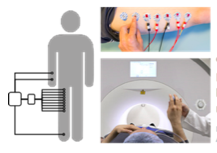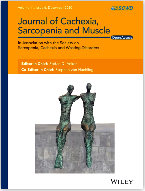
 The Institute of Myology teams have just published, in the Journal of Cachexia, Sarcopenia and Muscle, the results of a study demonstrating the significant potential of a non-invasive method to measure muscle volume. Interview with Damien Bachasson and Jean-Yves Hogrel, of the Institute of Myology’s Neuromuscular Physiology and Evaluation Laboratory.
The Institute of Myology teams have just published, in the Journal of Cachexia, Sarcopenia and Muscle, the results of a study demonstrating the significant potential of a non-invasive method to measure muscle volume. Interview with Damien Bachasson and Jean-Yves Hogrel, of the Institute of Myology’s Neuromuscular Physiology and Evaluation Laboratory.
What is the overall context of this project?
This project is part of the development of new non-invasive methods to assess muscle volume. The development of a method of this sort is crucial for clinicians and scientists in a number of situations where the muscle is affected, such as in neuromuscular diseases, but also ageing, chronic diseases (stroke; cancer; respiratory, rheumatological, cardiovascular and orthopaedic diseases; etc.), or physical rehabilitation and sports training.
The method presented in this work relies on the study of the electrical properties of the body’s tissues. The principle behind bio-impedancemetry is the introduction of an imperceptible electric current into the body and the study of how the body, as a result of its composition, modifies the introduced current. It is then possible to estimate, for example, the percentage of body fat mass. It is a very common technology that is used, for example, in consumer scales that estimate fat mass percentage. Conventional approaches rely on prediction equations that depend on the population being studied. These approaches do not work well when patients present significant loss in terms of quantity and quality of muscle volume; this limits the use of bio-impedancemetry as a tool for studies, diagnosis, or follow-up in a clinical context.
 What were the study objectives?
What were the study objectives?
In this work, we present a method to assess muscle volume in the thigh using bio-impedancemetry, relying on equations obtained using a comparison between the electrical properties of tissues and images obtained using MRI, which is the reference method. Twenty participants in a good state of health and twenty patients with moderate to severe idiopathic inflammatory myopathy participated in this study.
What results were obtained?
 We demonstrated a high level of consistency between muscle volume measured by our method and that measured by MRI, including among patients presenting low muscle volume associated with fatty muscle degeneration. We also showed a good level of reproducibility of the method.
We demonstrated a high level of consistency between muscle volume measured by our method and that measured by MRI, including among patients presenting low muscle volume associated with fatty muscle degeneration. We also showed a good level of reproducibility of the method.
What conclusions can be drawn and what developments do you foresee?
This method has a high degree of potential with a number of possible applications across the entire population, based on the principle that muscle mass is an indicator of public health, which a growing number of publications tend to show. We will continue this work in order to study the sensitivity to change of the measurement in clinical trials. We are also working on the industrial development of this approach. In particular, a patent has been filed. The creation of a start-up company promoting this method is also being studied.
** Damien Bachasson PT, PhD, is a researcher In the Neuromuscular Physiology and Evaluation Laboratory at the Institute of Myology (Paris)
*** Jean-Yves Hogrel, PhD, is the head of the Neuromuscular Physiology and Evaluation Laboratory at the Institute of Myology (Paris)
